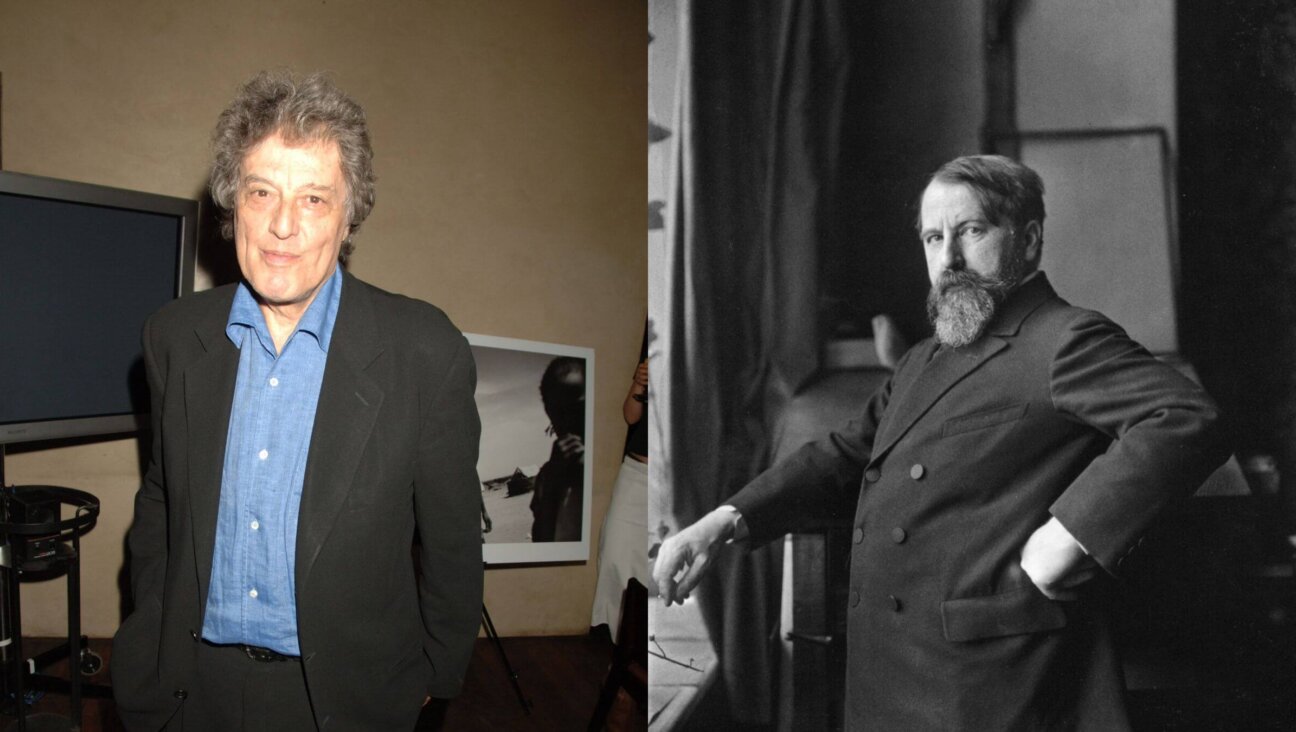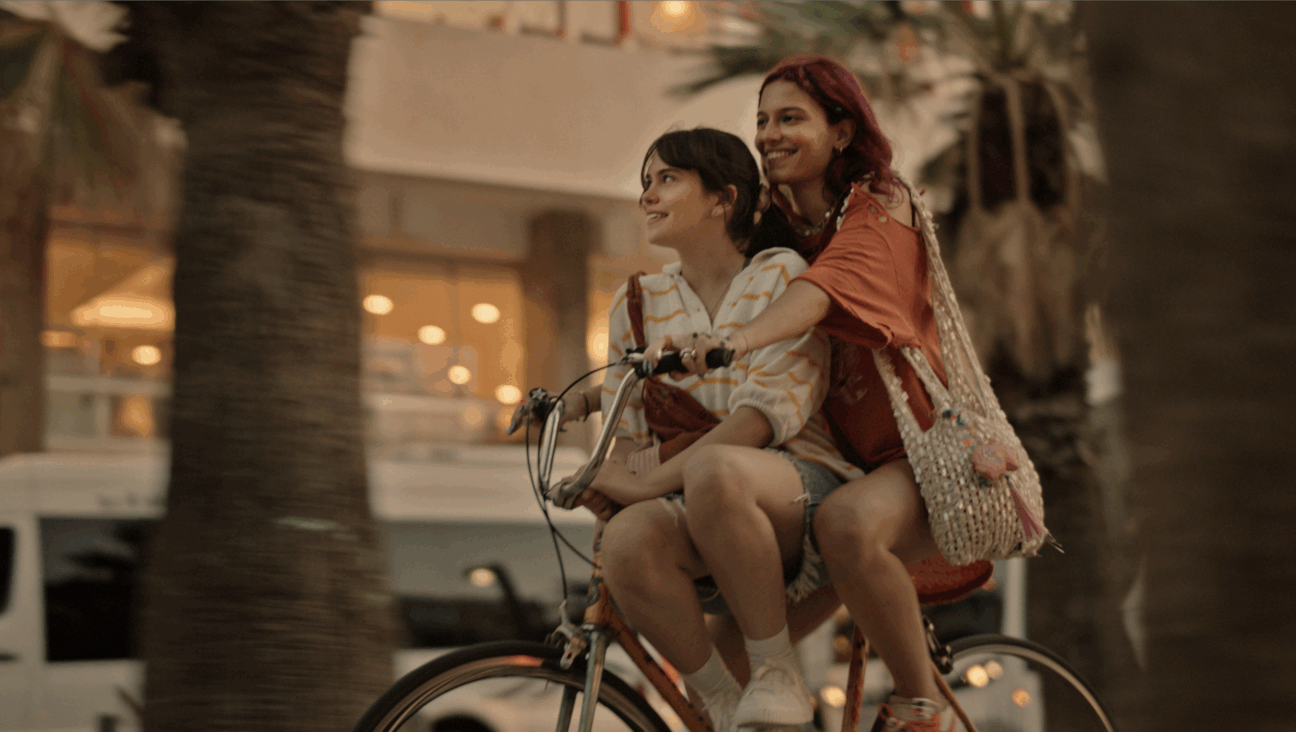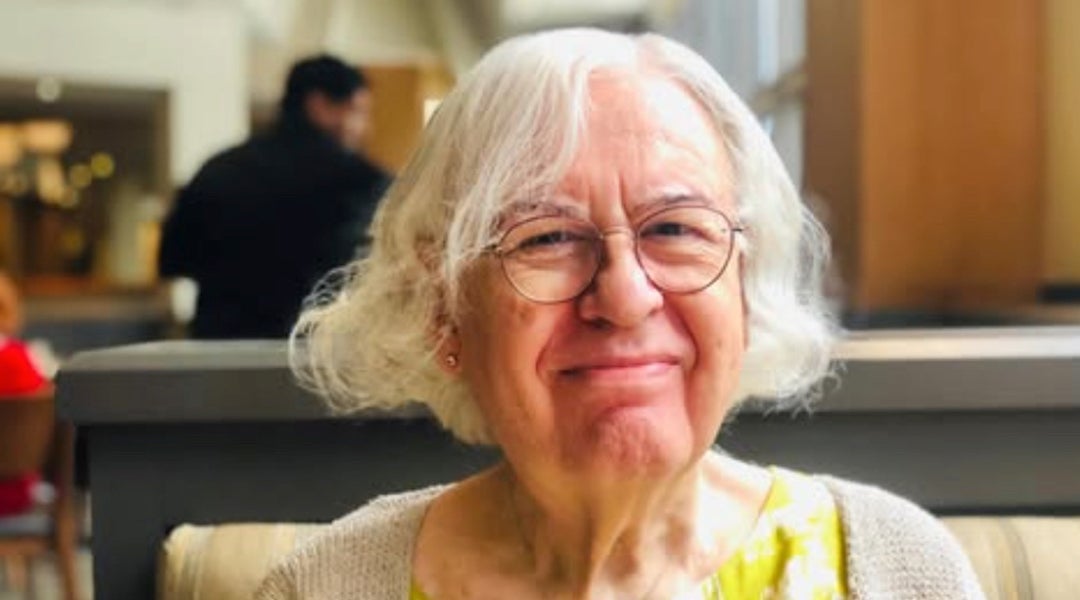Who Owns This Artist’s Legacy — His Family Or Yad Vashem?

The work of Joseph Bau Image by Naomi Zeveloff
In the Płaszów concentration camp, Joseph Bau used paper from cigarettes discarded by Nazis to make a deck of playing cards. But instead of kings, queens and jesters, the young artist illustrated the cards with scenes of normal life before the Nazi invasion: a wedding, a family outing, a doctor’s visit.
When fellow prisoners in Płaszów appeared to be contemplating suicide — jumping onto the electric fence was one common method — Bau would sidle up to them with his deck of cards in hand like an optimistic tarot reader and divine a better future.
Why do you want to commit suicide? he would ask, pulling out a card. Look: you’ll get married, you’ll have children, you’ll be a doctor.
Bau’s daughters believe that their father saved hundreds of people in the Holocaust. As a graphic designer in the Krakow ghetto, he forged documents and stamps for the underground. He recalled his participation in Akiva, a Zionist youth group active in the Nazi resistance in his 1990 memoir “Dear God, Have You Ever Gone Hungry?” (The English translation was published in 1996).
Later, Bau falsified papers that allowed Oskar Schindler to obtain rations for the thousand plus workers he sheltered in his factory in Brünnlitz in the Czech Republic. But Bau’s most effective tool at helping others may have been his humor.
“He saved people with laughter,” said his eldest daughter, Hadassah Bau.
Bau’s unlikely optimism is the theme of the Joseph Bau House, a three-room museum in the artist’s former studio in Tel Aviv that his daughters, Hadassah Bau and Clila Bau-Cohen, have maintained since his death in 2002.

An Artist’s Legacy: The Joseph Bau House Museum is run by Bau’s daughters Clila Bau-Cohen and Hadassah Bau. Image by Naomi Zeveloff
The museum, on a shaded residential block in the city center, tells Bau’s life story, from his childhood in Krakow to his clandestine wedding to Rebecca Tannenbaum in the Płaszów camp — which was depicted in “Schindler’s List” — to his immigration to Israel, where he began a new life as a graphic artist. The museum includes piles of Bau’s artwork and a film projector that he built by hand. One cartoon hanging in the museum depicts Bau as both sculptor and sculpture, toiling to sculpt himself into a new man.
One item that the museum does not have on display is the original playing card set that Bau used to cheer up other prisoners. The cards are in Israel’s Yad Vashem Holocaust Museum, along with 25 other items that once belonged to Bau, including Bau’s uniform, bowl and spoon from Płaszów, as well as a model of the camp he created for an exhibit on the Holocaust at an Israeli high school and a set of six woodcuts he gifted to Oskar Schindler, the family says.
The Bau sisters believe that these items’ permanent home should be in their museum, not in Yad Vashem. Now, they are demanding that Yad Vashem give them their father’s works so they may exhibit them for the 15th anniversary of Bau’s death, this year, or for the 100th anniversary of his birth, in 2020. According to the sisters’ lawyer, Yair Maiman, Yad Vashem has indicated that it will loan the works, on the condition that the sisters drop their claim against Yad Vashem. (Yad Vashem declined to comment on this, citing the “ongoing negotiation” with the Bau family.)
The dispute between Yad Vashem and the Bau sisters centers on the question of whether most of the 26 items were donated or simply loaned to the museum. Yad Vashem maintains that they were given to the museum. The sisters say they were loaned with the stipulation that they would be exhibited, and since they are not, they should be in the family’s property. (Yad Vashem says the items are “accessible to the public,” and that two items are on permanent exhibit while others are “viewable via Yad Vashem’s website.”)
To back up its position, Yad Vashem’s lawyers sent Maiman two letters of receipt, one to Bau himself in 1983 and one to the Bau sisters in 2003, thanking them for their donations of several of Bau’s works. Maiman countered that without letters from the Bau family, there is “no consensus” that it meant to give the items away for good. (Maiman provided his correspondence with Yad Vashem’s lawyers to the Forward.)
Now, the sisters are contemplating Yad Vashem’s offer to loan the items.
While most of Bau’s works came to Yad Vashem through the Bau family, some reached the museum through other, more complicated routes.
One of these items is an intricate model of the Płaszów camp, with miniature barracks in beige and grey surrounded by a wire fence. Bau had memorized the layout of the camp when he was ordered to create a map of Płaszów for the Nazis. Later, recalling the camp’s every nook and cranny became a way for Bau to explain the Holocaust to the world.

On His List: Bau painted a portrait of Oskar Schindler, the man who saved him.
“Lest its existence fade into oblivion, I shall try to reconstruct Płaszów from the shards embedded in my consciousness, to construct a model of this veritable hell on earth,” he wrote in his memoir. “I owe it to the countless camp inmates, those who died there and those who will carry its imprint on their souls to the end of their existence.”
The model arrived at Yad Vashem in 2004 via the Association of Cracovians in Israel, a group of Krakow natives that had used it for an exhibit at a Tel Aviv high school. According to Lili Haber, the group’s chairperson, Bau had donated the model to the association in the 1980s. But the Bau sisters said they had no knowledge of the donation, and believed that it should have been given to them when the high school exhibit closed.
A murkier case is that of the six woodcut prints that Bau gave to Schindler. After the war, these prints were found in a suitcase that once belonged to Schindler. The suitcase, which also held versions of Schindler’s fabled list of Jews, arrived at Yad Vashem in 1999, but its provenance is under dispute.
Maiman is representing Argentine journalist Erika Rosenberg in a lawsuit against Yad Vashem to acquire the suitcase, which she claims belongs to her.
According to Haaretz, Rosenberg was a close associate, biographer and beneficiary of Emilie Schindler, Schindler’s wife, who is now deceased. After the war, Schindler and his wife separated, though never divorced, and Schindler began a relationship with German Annemarie Staeher, also now deceased.
Rosenberg claims that Staeher stole Schindler’s suitcase after he died and stored it in her home for 25 years, where her sons discovered it. Her sons delivered it to a German newspaper, whose Jerusalem correspondent brought it to Yad Vashem.
Rosenberg claimed that she tried to wrest the suitcase’s contents for Emilie Schindler after reading the article in the German paper, but by the time her lawyer acquired a court order to search the paper’s offices the suitcase was already gone. In Haaretz, Yad Vashem has proffered a totally different version of the story, claiming that Schindler gave the suitcase to Staeher while she was alive and that her sons donated the artifacts inside, including the Bau prints, to the museum legally.
Rosenberg said that as Emilie Schindler’s beneficiary — the two became friends late in Emilie Schindler’s life — the items of the suitcase, including Bau’s paintings, are rightly hers. But she told the Forward that if she got the suitcase back she would give the woodcuts back to the Bau sisters.
“The Bau collection belongs to the family Bau,” she wrote in an email.
According to Maiman, the case is pending before an Israeli court.
In the meantime, the Bau sisters say they are frustrated with Yad Vashem for not giving them items they want to display. Yad Vashem is not an “enemy,” said Hadassah Bau, but she believes in this case the museum is not sticking up for survivors.
“With respect to all of these items, Yad Vashem acquired them legally and transparently and is their rightful owner,” Yad Vashem said in a statement to the Forward. “At Yad Vashem, the items are properly preserved and cared for, to ensure their survival for generations to come.”
Unlike many other children of survivors whose parents kept silent about the Holocaust after they had reached safer shores, the Bau sisters know their parents’ stories so intimately it was as if they endured the camps too. Their mother and father wanted to pass on their firsthand accounts so that the world would never doubt that the Holocaust had occurred, they said. And unlike the children of survivors who grew up under the weight of such knowledge, the Bau sisters said that knowing the stories made them proud, not depressed.
“We felt very strongly that our parents were heroes, not victims,” said Bau-Cohen.
Sitting in their father’s studio-turned-museum in between paid tour groups that barely keep the ramshackle gallery afloat, the Bau sisters took turns sharing their father’s story over Moroccan cookies and tea. He grew up in Krakow in the 1920s, where his parents owned one of the city’s first chocolate shops. His mother, a successful hat maker, was forced to become a worker in her own store and was eventually forced out altogether after the family moved to the Krakow ghetto.
Bau studied at the University of Plastic Arts in Krakow for only a year before the Nazi invasion of Poland, but he was able to parlay his basic knowledge of German gothic lettering into work for the Nazis. He brought with him his drafting table and an art case that had a false bottom under which he stored family photos. When the camp closed, he lost the case for a time, but was miraculously reunited with it at Schindler’s factory.
In the ghetto, Bau’s 13-year-old brother was killed when a Nazi brutally twisted his head, breaking his neck. Bau rarely talked about him and hardly mentioned him in his memoir. It was one of a few painful episodes that even he could not recall aloud. Another brother survived the war. Bau’s father was shot by a Nazi in the Płaszów camp, and Bau wanted to provoke his father’s killer into shooting him too but a friend stopped him, convincing him that artists had to survive the war to teach the world about what happened.
A few days later, a Nazi commander asked Bau to copy a map using a technique that involved sun exposure. It was a cloudy day and Bau, terrified that the copy wouldn’t come through, held the paper up to the sky. Just then, a female prisoner walked by and asked him what he was doing. He told her he was looking for the sun, and then flirtatiously suggested that she might serve as a substitute.
Not long after, he married Tannenbaum, who later went by Rebecca Bau, in a secret ceremony in the women’s side of the prison camp. It was Rebecca Bau who secured her husband a spot on Schindler’s list. She had stepped in earlier when a Nazi threatened to kill the mother of the Jewish secretary of Amon Goth, the terror-inducing commander of the camp. The secretary now returned the favor by getting her onto the list. She asked Schindler to put Bau’s name on the list instead of her own, a fact that Bau learned only decades later when a journalist was interviewing the family during the “Schindler’s List” release. Rebecca Bau was sent to Auschwitz.
After the war, Bau found his wife in a hospital where she was recuperating from an injury. He tried to move back into his family home in Poland, but was warned by neighbors that the people who had moved into his home would kill him for being Jewish. Instead, he moved next door and watched and waited to see whether his mother would come home. She never did. When her camp was liberated, she and many other prisoners died from eating rich food supplied by the allies after having starved for so many years.
Bau became a prominent Polish newspaper cartoonist, but he was heavily scrutinized under the Communist government and decided to make good on a long held dream to move to Israel with his wife and young daughter. Hadassah was the first child born to a Schindler survivor.
Bau stayed very close with Schindler, who called him his “son” and Hadassah and Bau-Cohen his “granddaughters.” Whenever he would come to Israel, Bau would organize the Schindler survivors to meet the Righteous Gentile awardee at the airport and they would gather in Bau’s studio for refreshments.
In Israel, Bau became known for his inventions and artistry and created several new Hebrew fonts. After his death, his daughters said they learned he was the Mossad’s chief graphic designer and that he falsified documents for Elie Cohen, the Israeli spy in Syria who gathered intelligence crucial to Israel’s Six-Day War victory and who was hanged in Damascus for his deeds.
Yet while Bau should have been famous in his day, his secretive work and the fact that he rarely signed his own art — or used a graphic flourish only legible when turned on its side — has left him a relatively unknown survivor to this day.
The Bau sisters want to elevate their father and his unique life story and artwork with a traveling exhibit. They hope that the deck of cards — now housed in Yad Vashem — will be part of it.
Naomi Zeveloff won a 2016 Sigma Delta Chi award for her Forward story ‘What Ever Became Of The Children of Jerusalem?’















